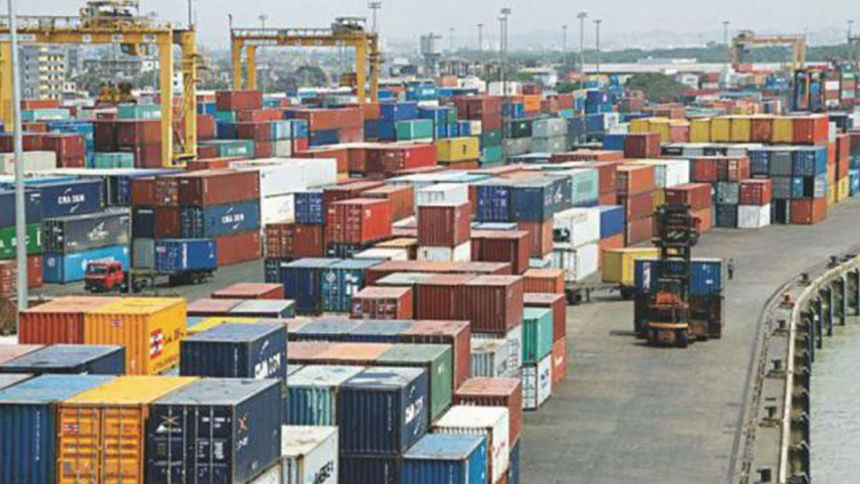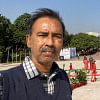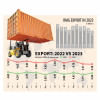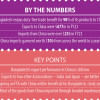Export target set at $63.5b, eying US tariff advantage

The government has set a high export target of $63.5 billion for fiscal year (FY) 2025-26, hoping to boost shipments to the United States by capitalising on Bangladesh's favourable position under the new US tariff regime.
Despite failing in the last three years, exporters are hopeful of achieving the target this time if the existing challenges, such as energy shortages, banking issues and customs hurdles, are resolved.
Of the total target, $55 billion is expected from goods exports, a 13.4 percent increase over last year, while services exports aim for $8.5 billion, marking an 18.7 percent rise, according to data from the Ministry of Commerce.
THE TARIFF BOON
While unveiling the export target at a press conference yesterday, Commerce Adviser Sk Bashir Uddin linked the ambitious goal to Bangladesh's advantageous US tariff status.
Under the new tariff regime announced by the Trump administration, Bangladesh enjoys a competitive edge in the American market, with an average tariff rate of 36.5 percent, comprising the newly imposed 20 percent reciprocal tariff added to the existing 16.5 percent.
This is considerably lower than many competing countries, some of which face tariffs as high as over 60 percent, providing Bangladesh a clear opportunity to expand its exports in the face of mounting protectionism elsewhere.
"We are actively negotiating to reduce non-tariff barriers and tariff rates, aiming to bring down duties from 20 percent to 15 percent or lower in many categories," the adviser said.
The adviser noted that many tariff lines, particularly for food items, already stand between zero and 1 percent. "These efforts aim to reduce the trade deficit with the US without undermining the economy's resilience."
On agricultural goods, particularly onions, the adviser said Bangladesh has not imported for a long time due to strong local production, though limited imports may be considered if necessary.
He noted that last fiscal year's high growth came from sustained efforts, including diversification, though more work remains both within the garments sector and in promoting non-traditional items.
US MARKET POTENTIAL THERE, BUT…
Industry insiders and experts, however, say there are several unresolved factors that would determine Bangladesh's export potential to the US.
"There are many challenges ahead," he said. "But… we believe we can do better than before," said AK Azad, chairman and managing director of Ha-Meem Group, one of Bangladesh's largest exporters to the US.
However, he noted that since the imposition of higher tariffs by the Trump administration, many buyers have reduced volumes and pushed for lower prices.
"Part of the tariff cost is being passed on to us, and part is being absorbed by the buyers. The government's ability to navigate these tariff negotiations will heavily influence whether we meet or exceed the target," the exporter said.
Azad also warned that problems like power shortages and political unrest could hurt export growth.
Khondaker Golam Moazzem, research director of the Centre for Policy Dialogue (CPD), said that while Bangladesh currently enjoys favourable tariff treatment in the US, the country's largest single-nation export destination, the persistence of such advantages depends on unresolved trade policy decisions.
"If additional tariffs on certain imports remain in place, our competitive edge in the US could hold," he said.
"But if American consumers reduce spending due to higher prices, our export growth may slow despite market advantages."
Moazzem also cautioned that overreliance on a few key markets could hinder diversification, especially as trade disputes with India threaten access for non-traditional exports.
He also noted that potential shifts in global supply chains could intensify competition in alternative markets from large exporters like China and India.
"While the target is realistic under current circumstances, sustaining high export growth will require broader market diversification and careful navigation of tariff-related uncertainties," he added.
The economist said that despite India's ban on imports through land ports, Bangladesh's exports are unlikely to have any significant impact on the new export target for FY26.
RESOLVING ENERGY, BANKING ISSUES CRITICAL
Some others think the export target is not just achievable, but could even exceed the goal, if the existing problems with the banking sector and energy supply are addressed properly.
"Our expectations have risen following the government's successful negotiations with the United States, which could create further opportunities to perform better. To seize these opportunities, certain domestic bottlenecks must be addressed," said Mohammad Hatem, president of the Bangladesh Knitwear Manufacturers and Exporters Association (BKMEA).
He identified the gas crisis, banking sector problems, customs delays, and law and order issues as the major challenges. "If these matters are resolved, we are ready to exceed the set targets."
He urged the commerce adviser to sit with businesses to find ways to resolve the bottlenecks.
Commerce Secretary Mahbubur Rahman voiced a similar confidence in achieving the export target.
"Compared to last year's target and achievements, the gap is minimal, about half a billion dollars, which shows our projections are realistic. If the domestic constraints are managed, I can confidently say we can surpass the target."
The secretary announced that the government will hold a meeting with businesspersons, the Energy Division and the banking sector representatives next week to address the bottlenecks.
He said Bangladesh is negotiating FTAs with Japan, South Korea, and Singapore, pursuing only those agreements that bring tangible benefits while trying to retain preferential market access for as long as possible.
SECTORAL TARGETS
The readymade garment (RMG) sector, the country's crown jewel of exports, has been assigned a combined target of $44.49 billion, including $20.79 billion for woven products (14.3 percent growth) and $23.70 billion for knitwear (12 percent growth).
Home textiles target has been set at $1.02 billion, up 17 percent, while leather and leather goods aim for $1.25 billion, reflecting a conservative 9.2 percent rise.
The frozen and live fish sector has a $539 million target, with expected growth of 22 percent.
Jute and jute goods exports are projected at $900 million, a 9.7 percent increase, with emphasis on lab testing and capacity building at the Bangladesh Jute Research Institute to ensure quality.
Agricultural products have been assigned a $1.21 billion target, reflecting 22.4 percent growth.

 For all latest news, follow The Daily Star's Google News channel.
For all latest news, follow The Daily Star's Google News channel. 








Comments